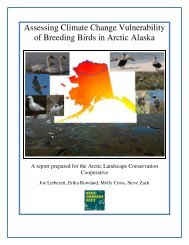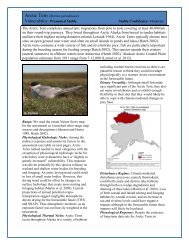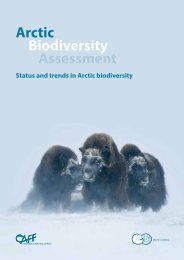Permafrost Terrain Stability and Thermokarst Monitoring: - Arctic LCC
Permafrost Terrain Stability and Thermokarst Monitoring: - Arctic LCC
Permafrost Terrain Stability and Thermokarst Monitoring: - Arctic LCC
Create successful ePaper yourself
Turn your PDF publications into a flip-book with our unique Google optimized e-Paper software.
8. Benninghoff, W.S., 1952, Interaction of vegetation <strong>and</strong> soil frost phenomena: <strong>Arctic</strong>,<br />
v. 5, no. 1, p. 34–44.<br />
This paper describes the influence of frozen soils on the establishment <strong>and</strong> propagation of<br />
vegetation communities, <strong>and</strong> the converse of this. Frozen soils exert great force <strong>and</strong> trauma<br />
on root systems of plants through repeated freeze-thaw cycles, differential frost heaving,<br />
cracks caused by rapid freezing, <strong>and</strong> so on. Plants have adapted shallow root systems to<br />
adapt to impervious permafrost, which make trees <strong>and</strong> shrubs easy to overturn in inclement<br />
weather or wind storms. Insufficient depth for the proper functioning of roots limits spruce<br />
forest, <strong>and</strong> species with flexibility of their root habits are most likely to establish themselves<br />
in permafrost areas. Furthermore, plants may be subjected to severe water loss by exposure<br />
to drying winds while roots are encased in frozen soil <strong>and</strong> cannot absorb water, which may<br />
also be a contributing factor that limits tree growth in permafrost terrain. <strong>Thermokarst</strong><br />
features caused by the melting of variable amounts of ice in the soil change the physical<br />
environment for vegetation occupying a site. Margins of lakes with high permafrost tables<br />
are particularly susceptible to destruction, In the Nebesna, Chisana, <strong>and</strong> Tanana River<br />
valleys of eastern Alaska, previous research estimated mean shore retreat of 2.3–7.5 in./yr.<br />
The oriented lakes of the <strong>Arctic</strong> Coastal Plain were shown as constantly changing, owing to<br />
caving of shores, draining, filling with peat, <strong>and</strong> initiation of new thaw cycles. All<br />
permafrost areas are characterized by the instability of the surface <strong>and</strong> consequent transience<br />
of site conditions. Vegetation also influences frozen soils. It shields the soil from maximum<br />
penetration of heat through shading, decreases air circulation, retains moisture in <strong>and</strong> just<br />
above the soil, prevents thaw through root systems, intercepts rain, <strong>and</strong> cools the soil<br />
through evaporation of moisture on plant surfaces. Mosses may play an important part in<br />
this effect. Removal of moss, thick turf, <strong>and</strong> surface peat greatly hastens thawing of frozen<br />
ground. However, vegetation also can warm soils by impeding heat radiation from the soil to<br />
the cold air <strong>and</strong> retaining snow cover, which insulates the ground from lower temperatures.<br />
Vegetation may be important for reducing frost disturbance in tundra through anchoring<br />
roots to the soil <strong>and</strong> the insulating effects of the aboveground plant parts. Because of soil<br />
frost changes following disturbance, the affected surface <strong>and</strong> the local environment may<br />
change so much that entirely different communities occupy the site for unknown time<br />
periods.<br />
9. Billings, W.D., <strong>and</strong> Peterson, K.M., 1980, Vegetational change <strong>and</strong> ice-wedge polygons<br />
through the thaw-lake cycle in arctic Alaska: <strong>Arctic</strong> <strong>and</strong> Alpine Research, p. 413–432.<br />
This paper provides an overview of the thermokarst lake cycle through the study of<br />
vegetation succession in a chronosequence of drained thermokarst lake basins near Barrow,<br />
Alaska. Pioneer species in recently drained lake basins consisted of Dupontia fischerii <strong>and</strong><br />
Arctophila fulva. As time passes since drainage, Carex aquatilis becomes more abundant as<br />
does the development of ice-wedge polygonal networks.<br />
6








